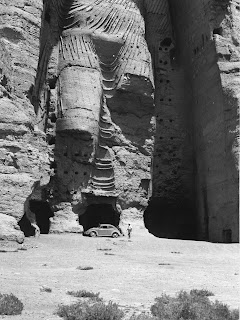One of our ARCA subscribers alerted me to a book published this year by Profile Books (UK) and Harvard which tells of the long history of the gigantic Buddha statues destroyed by the Taliban’s anti-artillery weapons in Afghanistan in 2001. My only knowledge of these objects is the furor created on international news of the videotape that showed the destruction of these cliff icons. YouTube has a video, “Afghanistan Taliban Muslims destroying Bamiyan Buddha Statues”, which supposedly interweaves the religious justification for this act of iconoclasm. But the destruction of the statues is not the point of Llewelyn Morgan’s book, which focuses on ‘their remarkably long lives’ (See "The Buddhas of Bamiyan by Llewelyn Morgan - review" by Samantha Subramanian in The Guardian, May 18, 2012).
Via Skype and email, Llewelyn Morgan, a lecturer in Classics at Oxford University, discussed his book, which tells of the survival of these symbols of Buddhism alongside one of the major trading routes of Afghanistan, a limb of the famous “Silk Road”, for more than 12 centuries. His book is based on
the recorded impressions of travelers such as Xuanzang, journeying through Bamiyan en route elsewhere…. Writings of surveyors, soldiers and antiquarians of the Raj … texts by Muslim travelers allow Morgan to parse the surprising malleability, over the ages, of Muslim attitudes towards this Buddhist iconography. [The Guardian, Subramanian]
Buddhism arrived in the Bamiyan valley in the 1st or 2nd century AD.
 |
| A German visitor in the 1950s photographed another tourist's car at the foot of the Buddha. Photo Courtesy of Edmund Mlzl. |
Dr. Morgan: It took me from starting research to submitting final proofs about 14 months. I had an interest in Afghanistan from a couple of sources. Like a lot of Classicists I was fascinated by the legacy of Alexander the Great and the Greek culture that persisted in Central Asia for centuries after him. Years ago, I was staying at my grandmother’s house (after her death), and was sifting through the antiques and knick-knacks she obsessively collected. I found a samovar and discovered that it was from Kandahar in 1881 during the Second Afghan War. Later I made friends with someone who was in charge of clearing mines in Afghanistan and he persuaded me to celebrate my 40th birthday by visiting the country.
ARCA Blog: What are your personal feelings after studying the history of these statues?
Dr. Morgan: It remains a terrible tragedy that they were destroyed. What I hadn’t realized before doing the research is what an immensely rich history that they had and what very significant monuments they had been for a variety of cultures. They were a wonder for three separate cultures, the Buddhists that created them, the Islamic peoples who followed, and then, in the 19th and 20th centuries, for the Western world. The 19th Century, when British and European travelers and spies rediscovered the statues, is a particularly fascinating period of history. The best way to compensate for an artistic crime is to fill in the proper meaning of these monuments.
ARCA Blog: Is this like the story of a murder victim?
Dr. Morgan: Indeed. Parallel to a murder victim. Rather like the Buddhas, most victims are anonymous until they are murdered. These Buddhas were very celebrated in the western world in the 1830s/1840s because so many people were writing about them. But their celebrity waxed and waned. In 2001 nobody had heard about them, their name recognition was restricted. Yet when I started talking about these statues, many people in their 50s and 60s who had visited as hippie travelers in Afghanistan brought me their photographs. The Buddhas of Bamiyan are now famous because they have been destroyed, and because of the circumstances in which they were destroyed, because their destruction was followed by the more serious events of 9/11.
Key to the story of the Buddhas is that there were on this major route between Central Asia and the Indian subcontinent, not the only route through the mountains of the Hindu Kush, but one favoured for its comparative easiness. Traders, missionaries and armies moved through there. For the British in 19th century, and in this they followed armies going back centuries, Bamiyan was a critical strategic military location, occupied by them in 1839/40 (a bulwark against the threat they believed was posed by the Russians).
The strategic location of Bamiyan and its position on the trade routes, all help to explain what made it a thriving Buddhist centre in the first place. Buddhism is a religion with very strong commercial instincts. Buddhist monasteries were banks and commercial operations as well as straightforwardly religious institutions. The gigantic Buddhas advertised the piety of this place to visitors, but also blazoned its wealth and power. The Buddhists of Bamiyan would have seen no contradiction in that, I don’t think. Buddhists and Muslims coexisted for a period at Bamiyan, we believe. But by 900 AD, there are no longer any Buddhists around. For 1100 years it has been a strictly Islamic community that surrounds it. But the statues had become an integral part of those Muslims’ home environment. The Muslims of Bamiyan are predominately Shiite, and the statues were incorporated into the Shiite mythology of the area, for example believed to be images of the last pagan king of Bamiyan and his wife, converted to Islam by Hazrat-I Ali, a kind of Islamic St George.

0 comments:
Post a Comment